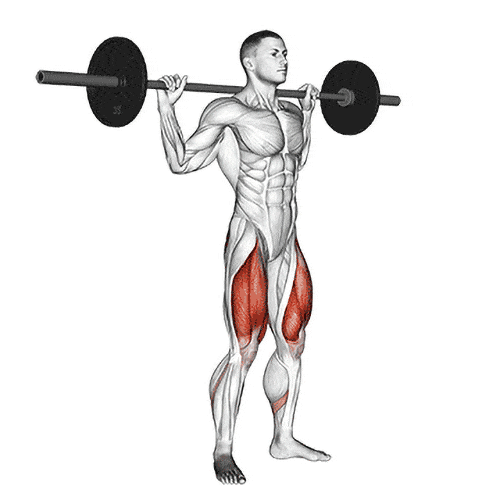Are you feeling out of shape? Do you want to build strength and get fit? Squats should be part of your exercise routine. But how many squats per day should you do?
Squats are a great way to build strength in your core and lower body, regardless of your fitness level. Although there's no one-size-fits-all answer, here is a guide to help you decide on the optimal number for you.
From beginners just learning the motion to advanced fitness enthusiasts looking for variations and extra intensity, this guide covers all levels and provides tips on staying consistent with your squat routine. Follow along to learn how many squats a day is the best way to get in shape!
What Is A Squat?

Squatting is an exercise that targets the body's lower extremity and core muscles. It is performed by bending the knee and hip muscles while lowering the body to a "sitting" position and then pushing the body back to the initial position.
Squats can be done with or without weights, and depending on your fitness level, many variations can be done to increase intensity or challenge different muscle groups.
What are the Benefits of Squatting?
Squatting is a great exercise that can benefit your overall fitness. Squats are an effective way to build strength in your lower body and core muscles, improve your posture, increase your vertical jump, and even help you burn calories faster.
Squats also help to strengthen the glutes, quads, hamstrings, and hips while improving balance and stability. Further, by strengthening the muscles surrounding the joints, squatting can reduce the risk of injury. The combination of these benefits has led to the popularity of squatting.
Incorporating squats into your daily routine can help to improve your muscular strength, boost cardiovascular fitness, and increase coordination, flexibility, and balance. Squatting is also thought to impact certain metabolic processes that regulate hormones responsible for muscle growth, which in turn can lead to an increase in lean muscle mass.
Types of Squats
You can do many different kinds of squats to focus on specific muscle groups and build your core. Some of them are:
Bodyweight Squats
Bodyweight squats are a great way to get into a challenging workout without the need for any external weights or equipment. To perform bodyweight squats, one should stand with their feet a little wider than shoulder-width apart and their toes pointing upwards.
Lower yourself into a squat position by bending at the knees and hips, keeping your back straight and core engaged. When you get to the base of the squat, wait a second before pushing through your heels to return to the beginning position. Continue as necessary!
Side-Kick Squat
Side-Kick Squat Using the side-kick squat can give you a great leg and glute workout. It combines the traditional squat with a dynamic kick to the side, which adds an extra challenge to the move.
The side-kick squat is performed in a squat position, with the feet at shoulder width apart and the hips back. As the weight is transferred to one leg, the other leg is lifted out to the side with the knee bent. Then, you squat on the opposite side. All movements should be performed with the core engaged.
This exercise will build strength and coordination in your legs and glutes. You can also add weights or resistance bands to make it more challenging.
If you want extra fun, try incorporating this movement into your workout!
Goblet Squats
Goblet Squat is a full-body movement that can build muscle and improve cardiovascular health. The hands should be vertically held, palms facing each other while performing a goblet.
Sit with the hips back and bend the knees to lower into a squat, holding the chest up. Maintain proper form when squatting. The glutes should be squeezed at the movement's peak as the heels are driven through.
Goblet squats are beneficial because they remove the tension of traditional back squats while still targeting the quads and glutes. It is also easier to perform on a squat rack. Having the best squat rack will make your exercise fun and exciting.
That the load is placed at the front of your body instead of behind it like in a back squat, which shifts our center of gravity forward and helps us maintain an upright torso position throughout the movement. This exercise can also help improve our ankles, hips, and upper back mobility.
Front Squats
For lower body strength, the front squat is a practical exercise. They are similar to back squats, but the bar is held in front of the chest instead of behind it. This position requires you to engage your core muscles more than with a back squat.
A front squat is performed by standing upright with one-foot shoulder-width from the ground and holding one or more barbells or dumbbells in front of the chest.
The arms should be bent so that the hands are above the elbows as if holding a cup. Once in the squat position, the body should rise back up. During the exercise, the back should be straight, and the weight should be held close to the body.
If you're new to front squats or just want some extra support while doing them, try using a weightlifting belt or having someone spot you while you do them. Warm up before any exercise, particularly a strenuous exercise such as this one.
Bulgarian Split Squats
The Bulgarian Split Squat is an effective exercise for building strength in the lower body muscles while improving balance and stability. This exercise can be performed with or without weights, depending on the individual's physical condition and objectives.
To do a Bulgarian Split Squat, Step up to a bench or chair about 2 feet in front of you, feet hip-width apart, core tight, shoulders back, chest up. Place one foot on the bench behind you and bend both knees until your rear knee almost touches the floor.
Your front foot should be pushed off to return to the starting position. Ensure that your torso remains upright throughout the exercise. Exercise variations can be used to target a variety of muscles and to increase intensity as needed.
How many Squats should I perform per day?
Generally speaking, as a beginner, you should aim for anywhere between 10-20 squats per day.
As your strength and stamina increase, you can gradually increase the number of squats performed daily. However, it is essential to exercise caution and not overdo it if you experience muscle pain or exhaustion.
Here are some tips to help you decide:
Beginner Squat Workouts
If you're just starting with squats, build a daily routine of 10-20 squats. Focus on perfecting your form while doing these bodyweight squats; this will ensure you get the most out of your workout.
Make sure to perform the squats slowly and carefully, taking 2-3 seconds to lower yourself, pause briefly at the bottom position, and then take another 2-3 seconds to rise back up.
As you become stronger, gradually increase the number of squats you do each day until you feel confident enough to add weight or complete more complex squat exercises. Adding weights and other challenges is a great way to keep your workouts fresh and effective!
Intermediate Squat Workouts
If you're an intermediate-level squatter, you can increase the intensity of your squats by performing 3–4 sets of 15–20 reps per day. If you've perfected your form with bodyweight squats, you can add weights to your workout for an extra challenge.
A good way to do this is to begin with lighter weights and gradually increase as needed. Also, try adding pause or pulsing squats at the bottom of each rep for an even greater challenge. Finally, consider adding unilateral exercises like single-leg Romanian deadlifts for added balance and strength in both legs.
Advanced Squat Workouts
If you want to take your squats to an advanced level, incorporate weighted squats and other complex variations into your routine. For example, do ten goblet squats with a kettlebell or barbell before performing ten jump squats.
You can also challenge yourself even further by adding plyometric box jumps into the mix; performing ten regular squats followed by five box jumps will help develop strength and power for more advanced movements.
Additionally, try mixing up your workouts with pause reps and unilateral exercises such as single-leg Romanian deadlifts for added balance and strength in both legs.
Cool-down and Stretching
After any squats workout, doing a cool-down before you finish your session is important. This helps your muscles relax and prevents cramping. Stretching is key to replenishing the suppleness and flexibility of your muscles after working out, don't forget to take deep breaths during this time!
Depending on the intensity of your workout, spend 5-15 minutes stretching out each muscle group worked e.g., legs, glutes, hips, and lower back in particular. By doing this, you can ensure you get the most out of your hard work!
Conclusion
Squats are an excellent lower body workout for strengthening and improving balance, coordination, and stability. It depends on your fitness level, what you aim to accomplish, and how many squats you need each day. Generally, it's best to start with a smaller number, like 2-3 sets of 10-15 reps, and gradually increase as your strength increases.
Additionally, warm up before doing any type of exercise especially one that involves heavy lifting as this one does. With these guidelines in mind, you should be able to identify how many squats per day is right for you!







Hi Team,
i am Ajay from Delhi India...